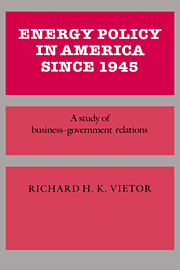Book contents
- Frontmatter
- Contents
- List of charts and figures
- List of tables
- Editors' preface
- Acknowledgments
- List of abbreviations
- 1 Introduction: The political economy of energy
- Part I The transition to peace and fluid fuels, 1945–1958
- Part II Managing surplus through the politics of stasis, 1959–1968
- Part III The second energy transition: adjustment to depletion, 1969–1980
- Index
1 - Introduction: The political economy of energy
Published online by Cambridge University Press: 13 October 2009
- Frontmatter
- Contents
- List of charts and figures
- List of tables
- Editors' preface
- Acknowledgments
- List of abbreviations
- 1 Introduction: The political economy of energy
- Part I The transition to peace and fluid fuels, 1945–1958
- Part II Managing surplus through the politics of stasis, 1959–1968
- Part III The second energy transition: adjustment to depletion, 1969–1980
- Index
Summary
This book has two objectives. One is to present the history of fossil-fuel energy policy in the United States since World War II. The other is to provide a useful framework for understanding how business and government interact.
The two objectives are not independent; they grow out of each other. The energy policies of the United States have been by-products of the nation's distinctive political economy. Policy-making was shaped in large part by government-business relations, American style, with non-business interest groups enlarging their political role during the 1970's. For better or worse, government intervention into the energy industries has been the norm not the exception. Through fragmentary initiatives that affected production, importation, and consumption of fossil fuels, the federal government fostered the energy conditions that prevail in the 1980's.
The course of relations between business and government has been governed by shifts in energy market conditions – changes in price or the parity of supply and demand. That fact is so strikingly pervasive that it is a major theme of the book, and I am making it the first of five general propositions about the American political economy at the end of this chapter. Changes in supply and price brought political pressures from producers, consumers, or government officials to restore the status quo or alter the effects of the market to serve distributive objectives not related to economic efficiency.
- Type
- Chapter
- Information
- Energy Policy in America since 1945A Study of Business-Government Relations, pp. 1 - 12Publisher: Cambridge University PressPrint publication year: 1984



